Other tectonic phenomena and the Wilson Cycle
We've been focused on subduction driven by slab pull as the essential feature
of modern tectonics. However, not all convergence can be easily explained by
local or far-field slab subduction. From what mechanisms do the other
forces arise?
Mantle convection requires that some material flow upwards while other material
flows downwards. The lateral length scales of upwellings and downwellings
would have a major effect on the strength and area of horizontal flow in the
upper mantle.
J. Tuzo Wilson was a Canadian geophysicist who made many major contributions
to plate tectonic theory. In 1963, he published a synthesized model
connecting the upwelling at the MOR to the downwelling at subduction zones
and the Wadati-Benioff Zone.
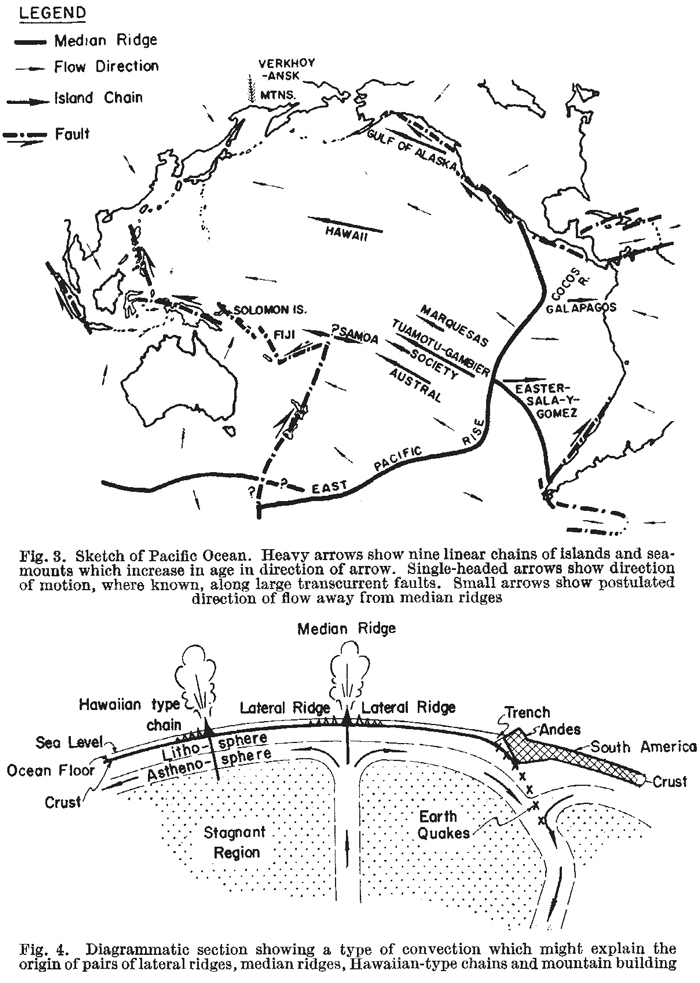
The Wilson Cycle (as it has come to be known) describes the repetitive opening
of ocean basins by seafloor spreading, and closure by subduction, resulting in
continental collision and orogeny, followed eventually by continental rifting,
leading to seafloor spreading. Table 1, published by Wilson in 1968, explains
the stages of the Wilson Cycle with reference to modern areas currently
exhibiting each stage:
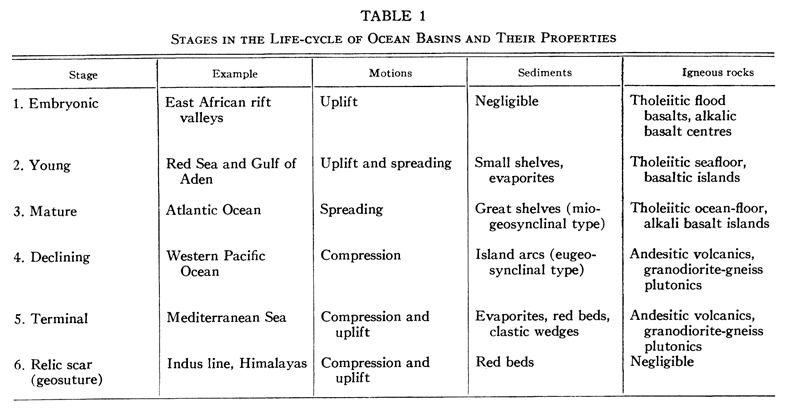
The model is advanced by the spatial correlation of orogenic belts with
areas of rifting, and by the general structure of continents consisting of
pieces of older continents. The model encompasses and relates together the
majority of the active tectonic boundaries we see on the earth today.
Except for minor additions and clarifications, the Wilson Cycle model is
essentially unchanged today, fifty years after it was described.
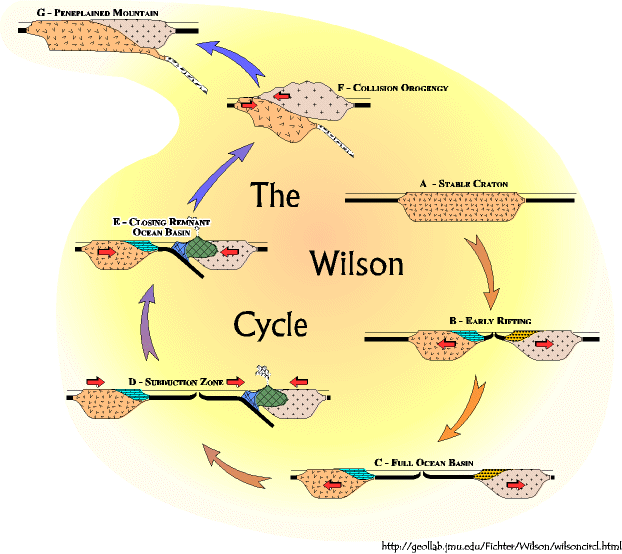
Source: http://csmres.jmu.edu/geollab/Fichter/Wilson/wilsoncircl.html
This model is commonly portrayed as the lifecycle of a continent or two,
but it can also be extended to the globe at large. Rifting and collision
are going on everywhere all the time. At a few points in Earth's history,
the spatial patterns of collision have contributed to the formation of Super
Continents. Evidence for these super continents is assembled by connecting
now-rifted correlative belts, particularly orogenic belts, and discovering
correlative dates of orogeny which seem to affect most or all of the preserved
crust of a particular age. Zhao et al. (2004) present a summary of the super
continent which formed at 2.1-1.8 Ga, and broke up about 1.6-1.3 Ga: Columbia.
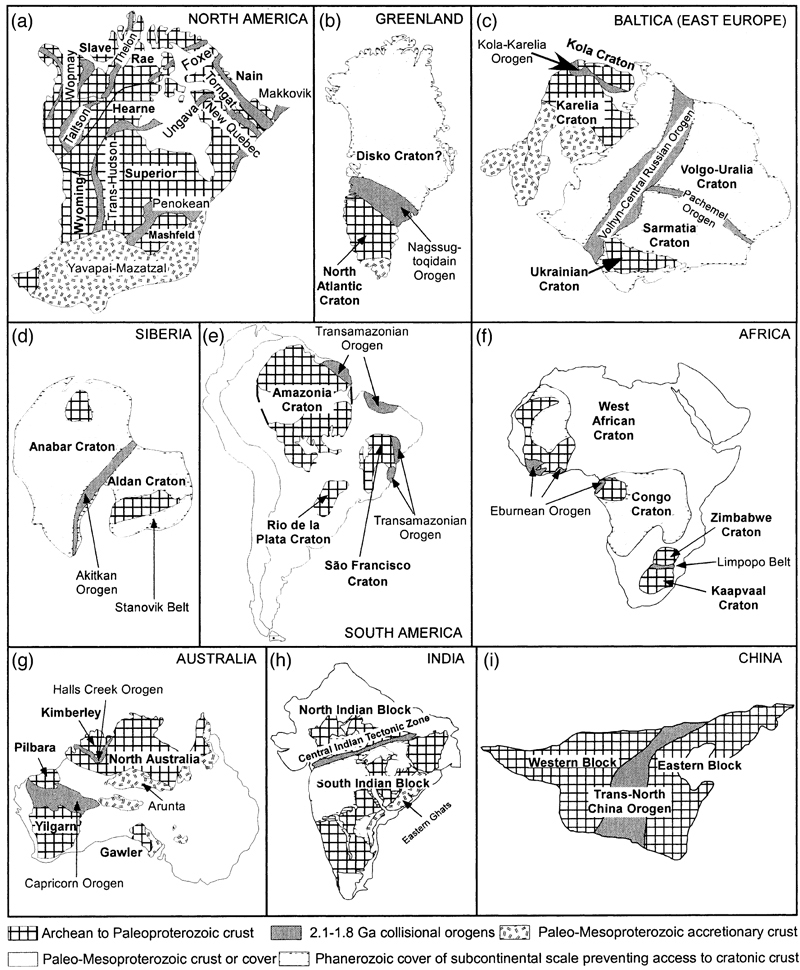
Orogens on 9 continents which all date to about a 300 My period are used as
evidence for this period being dominated by continental suturing, rather
than rifting and dispersal. The orogenic belts of this age (gray) suture
Archean (checked) and Paleoproterozoic (hatched) older cratons which were
sutured together. Some continents are mostly covered by younger rock (white).
Is this reconstruction unique? Probably not - paleomag evidence which could
pin continents together is pretty sparce at this age.
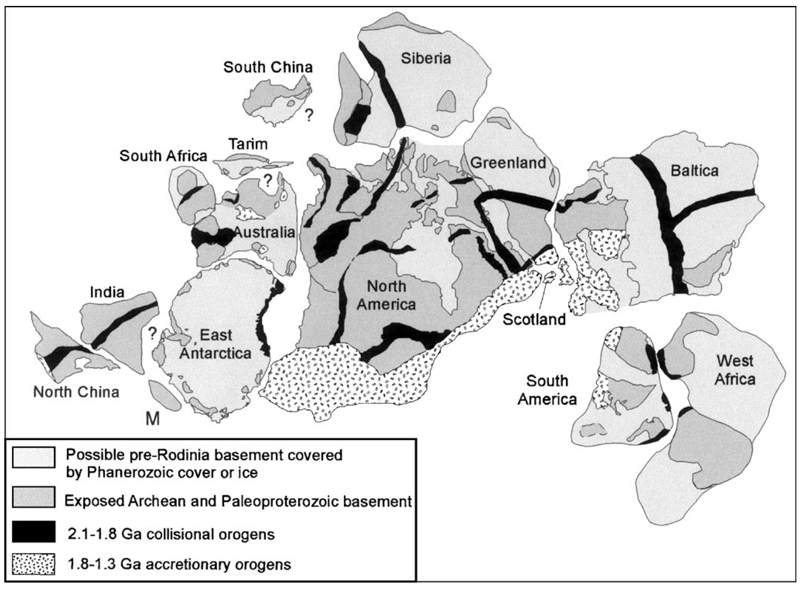
If the details of older orogenic belts were shown on this map, the older
cratons would also display a web of older collisions and sutures. The white
areas (cover and post-Columbia rocks) also hide many orogenic belts. Some of
these Columbia sutures have re-rifted (e.g. South America vs. West Africa)
and others are locked up in present continent interiors. These maps emphasize
that the surface exposure of crustal suture zones is not very predictive of
the location of future rifts - either because the relavent lithospheric sutures
are offset from the surface exposure of the belts, or because some sutures
become strong, or they just haven't met the right differential stresses or
temperatures yet but may rift in the future.
Geologic evidence seems to suggest that spikes in continental crust production
and orogeny (representing subduction and collision) occurred globally at 2.7 Ga,
1.9 Ga, 1.2 Ga, and 0.6 Ga. Is this repetition just serendipitous, or is there
some fundamental global process which has 500-700 My as a characteristic time
scale? Some authors have suggested that long periods of slab foundering may
insulate the D" layer and then the heat may be catastrophically released as
a burst of plumes. But, would a global plume swarm cause continental construction?
Or should it be correlated with continental rifting?
Condie (1998; 2000) points out that the breakup of one super continent seems
to sometimes overlap in time with the construction of the next. He also points
out that the known Phanerozoic orogens (the construction of Pangea, and
a possible intermediate supercontinent, Pannotia) are not apparently correlated
with a global spike in continental crust production.
 Other workers have suggested a superplume event in the late Cretaceous caused
fast subduction, voluminous arcs, and ocean island volcanism in the Pacific.
Heller et al. (1996) question the arguments that plume-driven volcanism was
increased during the Cretaceous. Marine sediments of this age show no evidence
for increased volcanic signature in seawater, and the pseudofaults
in the remaining ocean crust are evidence of ridge jumps and plate reorganization
but don't require acceleration. However, Condie (1998) and other supporters of
the idea argue that it can explain the long period of no magnetic reversals -
the Cretaceous Superchron. The plume release cooled the outer core
significantly enough to slow down the geodynamo and stop reversals. But, it
is not clear that the earlier events can be correlated to superchrons so this
may not be a general mechanism reaching back through the Proterozoic-Archean.
Other workers have suggested a superplume event in the late Cretaceous caused
fast subduction, voluminous arcs, and ocean island volcanism in the Pacific.
Heller et al. (1996) question the arguments that plume-driven volcanism was
increased during the Cretaceous. Marine sediments of this age show no evidence
for increased volcanic signature in seawater, and the pseudofaults
in the remaining ocean crust are evidence of ridge jumps and plate reorganization
but don't require acceleration. However, Condie (1998) and other supporters of
the idea argue that it can explain the long period of no magnetic reversals -
the Cretaceous Superchron. The plume release cooled the outer core
significantly enough to slow down the geodynamo and stop reversals. But, it
is not clear that the earlier events can be correlated to superchrons so this
may not be a general mechanism reaching back through the Proterozoic-Archean.
Condie (1998) suggests that prior to 1 Ga, the hotter mantle (as
compared to today) resulted in a stronger viscosity contrast between the upper
and lower mantle, with convection divided into two layers. The super plume
events would have temporarily disrupted the two-layer structure and a short
period of whole-mantle convection would have produced a whole-earth cooling
event.
This is not just about tectonics - McKenzie et al. (2014) argue that global
periods of heightened arc volcanism, and their role in degassing mantle
CO2 to the atmosphere, are correlated to long term cycles of climate. Hot
times are associated with reductions in biodiversity, and cold periods to
diversification. Hoorn et al. (2013) show that periods of mountain building
are correlated with biodiversity, as they create tectonic barriers to
migration as well as elevation-stratified environments. Increased continental
weathering feeds marine productivity.
Recent discoveries and ongoing challenges
Subduction underplating of extended continental margin
Taiwan is an intensively deformed terrane pile-up island currently subject to
collision and rotation as the Philippine Sea Plate and the Eurasian plate
are both subducting under the other:

Image from Anderson after Ernst
The N-S trending Manila Trench on the west coast of the island is closing from north
to south as the upper plate (including Taiwan) impinges on the rifted
margin of south China. The E-W trending trench extending east of the island
is where the Philippine Sea Plate (including a small inactive ridge) is
subducting under the Ryuku Arc - Okanawa Trough (3000-km long back arc basin).
Taiwan itself is composed of some old arc fragments, recent arc materials, and
highly deformed sediments of the accretionary wedge.
Lester et al. (2013) reported the results of seismic surveys extending across
the South China Sea, across the Manila Trench. The crustal structure interpreted
from these surveys shows that the seafloor in the South China sea is not
typical oceanic crust, as was assumed prior to the seismic survey - actually,
the continental margin was hyper-extended during rifting, leaving an extremely
attenuated layer similar in thickness to oceanic crust. Perhaps due to its
buoyancy, it is underplating under Taiwan forming repeated nappes. The
continental crust is being built from underneath!
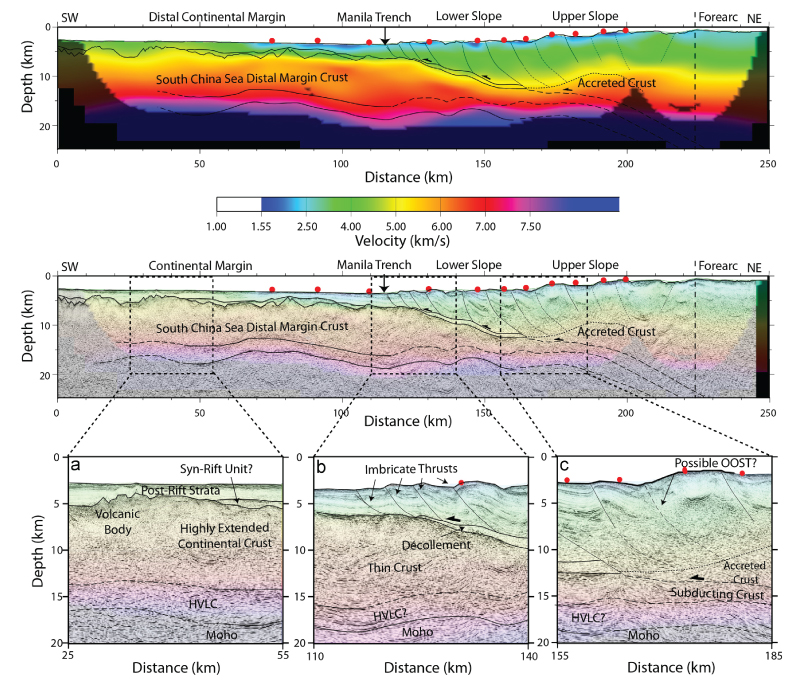
References
Condie (1998) Episodic continental growth and supercontinents: a mantle
avalanche connection? Earth & Planetary Science Letters v. 163 97-108.
Heller, Anderson and Angevine (1996) Is the middle Cretaceous pulse of rapid
sea-floor spreading real or necessary? Geology v. 24 n. 6 491-494
Hoorn, Mosbrugger, Mulch and Antonelli (2013) Biodiversity from mountain
building. Nature Geoscience v. 6 154
Lester, McIntosh, Van Avendonk, Lavier, Liu and Wang (2013) Crustal accretion
in the Manila trench accretionary wedge at the transition from subduction to
mountain-building in Taiwan. Earth & Planetary Science Letters v. 372 430-440
McKenzie, Hughes, Gill and Myrow (2014) Plate tectonic influences on
Neoproterozoic-early Paleozoic climate and animal evolution. Geology v. 42 127-130
Wilson (1963) Hypothesis of Earth's Behaviour. Nature v. 4884 925-929.
Wilson (1968) Static or Mobile Earth: The current scientific revolution.
Proceedings of the American Philosophical Society. v. 112 n. 5 309-320
Zhao, Sun, Wilde and Li (2004) A Paleo-Mesoproterozoic supercontinent: assembly,
growth and breakup. Eart-Science Reviews v. 67, 91-123








